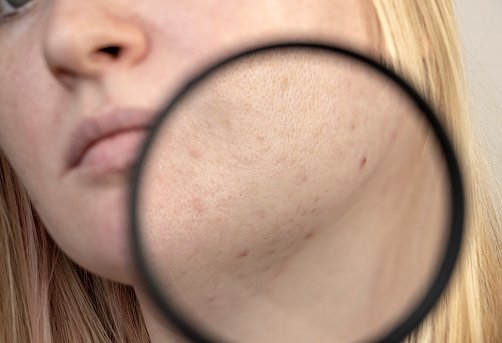Why this
form button?
A blind pimple refers to acne that has developed below the surface of the skin. Although the pimple is not visible from afar, you can feel the bump. It is most often caused by a cyst or nodule.
This type of acne develops from a combination of sebum (oil), bacteria, and dirt that accumulates in your pore. The end result is a painful pimple under the skin that doesn’t have a “head” like other pimples may have.
You might notice a large white area under your skin that is painful to touch. The area may also be red due to inflammation (swelling) of the surrounding skin.
Blind pimples can be difficult to get rid of, but they can be treated with patience and care. Here’s how.

1.Avoid the urge to squeeze and pop.
As tempting as it may be, you should never try to squeeze or pop a blind pimple. You’ve probably heard this general rule regarding acne in general, but it’s especially crucial to follow with blind pimples.
Because these pimples aren’t on the skin’s surface, they’re harder — and sometimes even impossible — to pop.
Trying to push the pimple out ends up making the inflammation worse, which can make the area more tender to the touch. It may even become even more noticeable due to increased redness and marks on the skin.
Attempting to pop blind pimples can also cause scarring.
The best thing to do is to take steps to try to bring it to a “head” so it can come out of the skin through other treatment methods.
2.Apply a warm compress
Warm compresses can help blind pimples in several ways. First, they can help relieve the pain caused by acne. They are especially useful when a whitehead begins to form.
Apply the hot compress for 10 to 15 minutes three to four times a day . This can allow the pimple to release pus and heal.
Although you can buy hot compresses to warm yourself in the microwave, you can easily make them yourself by soaking a clean washcloth in hot water. Make sure the water is not too hot to avoid burning your skin. Apply the towel to the affected area as directed above.
3.Wear an acne sticker
An acne sticker is like a bandage that you place directly over the blind pimple. In theory, the sticker helps remove bacteria, oil and dirt. Ingredients may vary, but most acne stickers contain an anti-acne agent, such as salicylic acid.
Acne stickers are usually available at your local pharmacy and can be used daily until the blind pimple is gone. You can wear them all day, but be sure to change the sticker at least once every 24 hours.
4.Apply a topical antibiotic
Topical antibiotics can help get rid of any bacteria that are contributing to the blind pimple. They also reduce inflammation. If you have recurring blind pimples, these products can be used around the affected area as a preventative.
The most common topical antibiotics for acne include clindamycin and erythromycin. It is a gel formula that you apply twice a day. If you generally have sensitive skin, you may need to apply once a day and see how your skin reacts before moving up to twice a day.
However, topical antibiotics are not effective on their own. You will need to use them in conjunction with another type of acne product like benzoyl peroxide. The antibiotic eliminates bacteria and inflammation, while the benzoyl peroxide dries up the blind pimple.
5.Apply tea tree oil
Tea tree oil can serve as a gentle alternative to harsh antibiotics and over-the-counter (OTC) chemicals. You can find the oil at a natural health store, but there are also tea tree oil products available at the drug store.
For optimal effectiveness, you should use a product containing at least 5% tea tree oil. Apply twice a day until the blind pimple heals completely.
Pure tea tree oil cannot be used until you have diluted it first. To do this, mix one part tea tree oil with one part vegetable oil. Popular carrier oils include coconut, jojoba, and olive oils.
After dilution, apply to the affected area and leave on overnight. Rinse the area in the morning during your usual face washing routine.
Tea tree oil is safe enough for daily use. It is only harmful when ingested.
6.Apply raw honey
Raw honey is another natural alternative to over-the-counter products. Honey has natural antimicrobial properties that help eliminate bacteria.
To use this method, make sure your product contains raw honey. You’ll want to avoid the typical honey that you can get at the grocery store. Apply a small amount to the affected area and leave on overnight. Raw honey can also be mixed with water as a cleanser.
When to consult your dermatologist?
Blind pimples are one of the most difficult forms of acne to treat. It takes time and perseverance to get rid of the pimple while avoiding damage to your skin.
If a blind pimple isn’t responding to home treatments, consider seeing your dermatologist. They can also offer solutions if you need a quick fix, such as cortisone injections to quickly reduce swelling and promote healing.
You should also see your dermatologist if you have recurring blind pimples on a regular basis. Oral medications and other treatments may be needed.